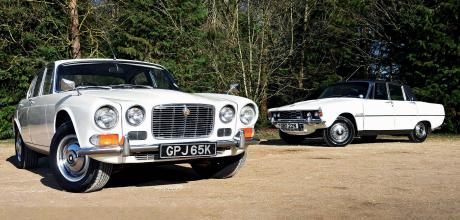1971 Jaguar XJ6 2.8 Automatic Series 1 vs. 1973 Rover P6 3500S
If you were doing well in the early 1970s, a Rover P6 3500 was almost a badge of rank. But if you were doing really well, its British Leyland sister car the Jaguar XJ6 would be within reach. But was the jump from a Rover to a 2.8 XJ6 really worth it, or would you have been better saving for a 4.2?
WORDS: SAM SKELTON
PHOTOGRAPHY: PAUL WALTON
JAGUAR AND ROVER DUEL IT OUT IN THE BRITISH LEYLAND BATTLE
XJ6 2.8 V ROVER P6 3500 British Leyland siblings fight it out; we decide a winner.
BOARDROOM DECISION
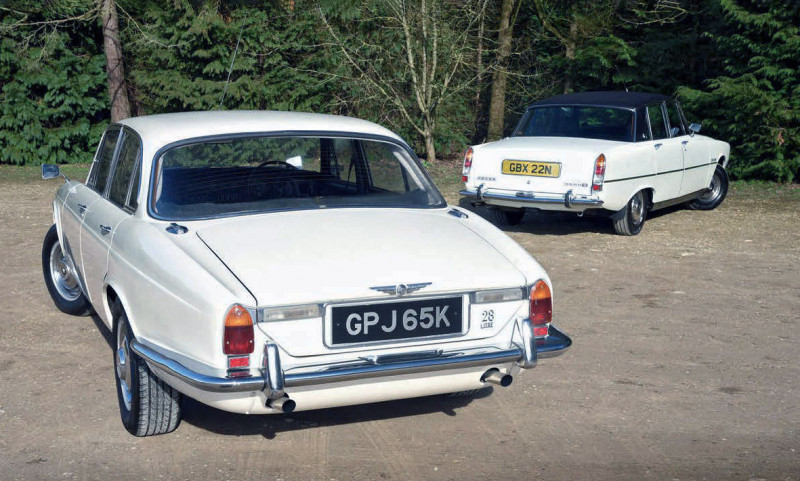
Image has always been one of the biggest driving factors when it comes to buying a large and expensive car – and Jaguar’s XJ is no exception to that. When the company downsized from its complex 1960s saloon car range into a single model, no doubt it was hoped that the halo effect of the larger engined and more expensive models would filter down to the entry level 2.8. While Jaguars have always been good value, the entry level XJ seemed to offer better value still by dint of its appearance; looking like a car from a class above.
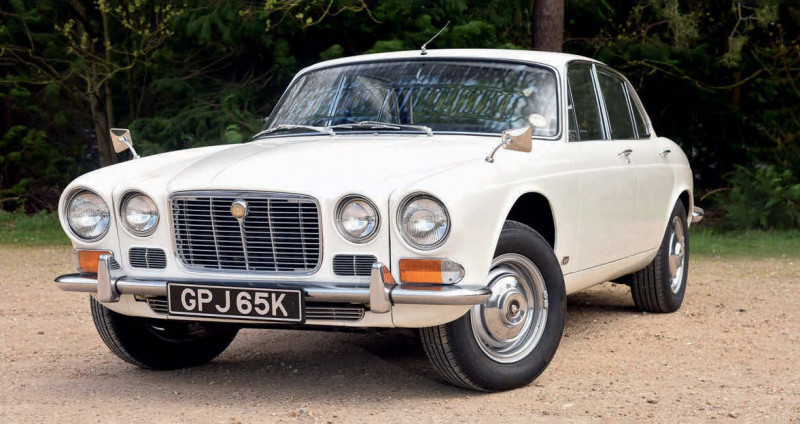
And its image was impeccable at the time. Having lost the association with people like the Krays and the Great Train Robbers, Jaguar was starting to offer the same level of quiet respectability that, even five years earlier, would have been the preserve of marques like Rover. Now sister companies under the auspices of British Leyland, Rover and Jaguar products were starting to appeal to the same type of person.
There was a natural progression, too – from the former Mk2-rivalling P6 models into the XJ. The 2000 might have been far further down the ladder, but Rover’s 1968 launch of a 3.5 litre V8 in the Three Thousand Five (facelifted into the 3500 for 1970) effectively offered an ideal bridge for the respectable type who couldn’t quite stretch to XJ ownership in the absence of the older S-type models.
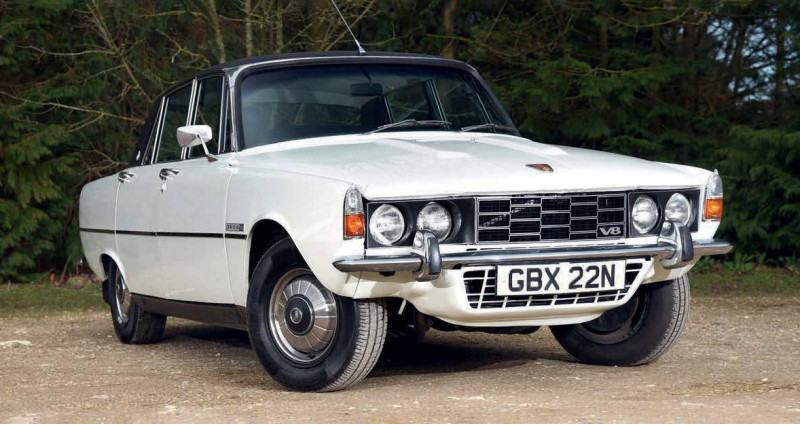
Between it and the entry level XJ, a successful executive might plot an automotive route from Rover 2000 to 3500, into the realm of the XJ with the 2.8 and through to the 4.2.
£1683 bought the Rover 2000, £2058 bought a 3500, an XJ6 2.8 Deluxe was £2574 and the 4.2 £2862. That would have been an achievable route for a bright young spark in a local bank, aspiring toward the manager’s chair.
Within ranges, progress was clear – but was the jump from V8 Rover to 2.8 litre Jaguar the same sort of forward step? And today as classics, which makes a better buy? The only way to answer that is to put them head to head.
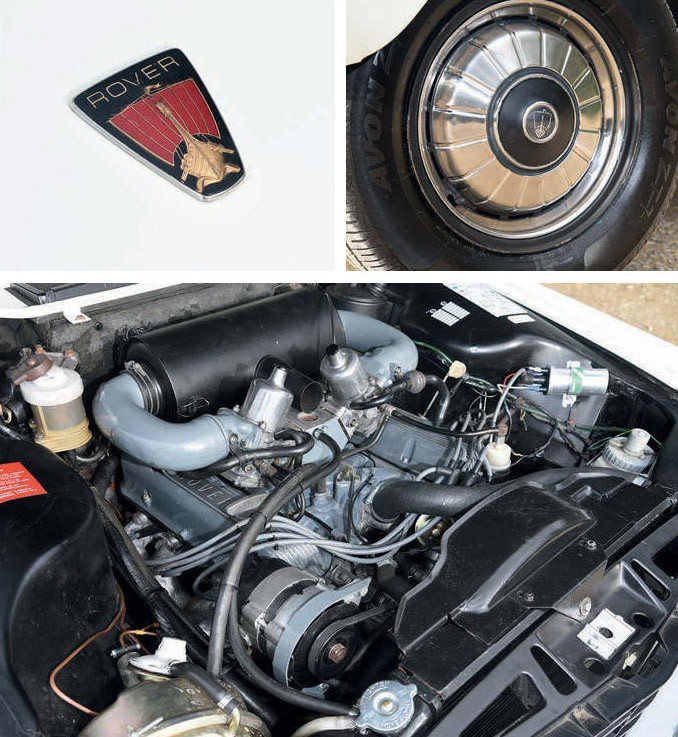
Rover launched its P6 in 1963. It was a radical move for what many have seen over the years as a conservative company, but it was far from its only bold move. In the late 1940s Rover had studied Studebakers to create the P4, an all new car utilising freewheel technology alongside a bold shape. Rover too had pioneered jet power for cars, with three prototypes surviving to this day. The P6 was a clean sheet design, aiming for the same sort of market as the Jaguar Mk2 2.4 but in a less traditional manner that younger buyers would find appealing. The styling and body engineering were inspired by Citroën's radical DS — while the suspension design was unorthodox it retained the use of coil springs alongside a deDion rear end. Complaints of sluggish performance were addressed with the 1966 2000TC with twin carburettors, and eclipsed completely in 1968 by the V8-engined Three Thousand Five model. A facelift in 1970 saw the V8 renamed the 3500 to match the four-pot naming structure, and a manual gearbox was made available for the 3500S the following year. The four-pots became 2200s for 1974 – and this was the final major change before production ended in 1977. The last P6 – an Avocado Green 3500S – survives in the hands of an enthusiast. The Jaguar was launched in the same year as the V8 Rover – both marking 55 year anniversaries of their 1968 launch.
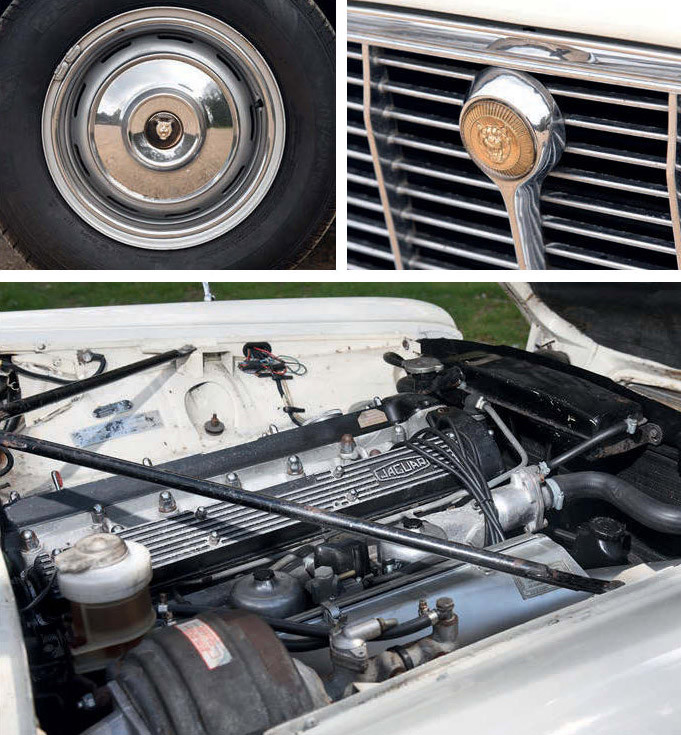
It had a tough job, as it was replacing six separate models – the 240, 340, 3.4S, 3.8S, 420 and 420G – with a planned range of just two – a new 3.0 six and a V12. With neither engine ready on time, Jaguar shoehorned in the old 4.2 litre XK unit, and created a new 2.8 litre version for European markets where car tax rates became punitive at the 3.0 mark. The V12 would eventually be made available for 1971. Styled by Sir William Lyons in a process which evolved from concepts centred around a four door E-type, the new car looked like a squared off and modernised take on the theme begun by the 420 saloon of 1966. This was reinforced by the new Daimlers of 1969 – which, like the 420-based car, were termed Sovereign.
The 2.8 replaced the Daimler V8-250, the 4.2 replaced the older Sovereign model. While the reduced lower range left a market open for Rover, this was no bad thing as ultimately British Leyland would see the profit in either instance. By the launch of the 1971 XJ12, Jaguar felt it could lay claim to the title of “best car in the world” – especially with the 1972 introduction of the long wheelbase and Daimler Vanden Plas, which offered Rolls-Royce beating Luxury at half the price. For 1973, Jaguar would replace the XJ with a facelifted version, the Series II. The short wheelbase would be axed for 1974, but a new Coupe would sit on the original wheelbase. The Series XJ6 would last to the end of Series III production in 1986 – the V12 would continue for a further six years. Eventually XJ40-bodied models would replace both.

Two cars with a clear link, then – and a logical progression from one to the other. But was the step up in price for the XJ6 2.8 also a step up in terms of the car you got, or was the Rover P6 3500 a better bet from an objective perspective?
Look beyond the surface and you can see the evolution from Mk2 and Jaguar E-type in the XJ, even if it’s a far cry from the soft curves of the 1960s. There’s still that sense of energy in the haunches over the wheels, that masked aggression in the hooded headlamps taking the place of the leaping cat as the main mascot at the nose. The back is far less fussy than older Jags though – dainty tail lamps, reversing lamps hidden in the chrome finisher and some little wings rather than a full bootlid plinth for the number plate – the plate lamps are housed in the bumper. It’s delicate and simple without being unfinished. The same goes for the simple radiator grille, flanked by horn grilles. It’s a simple shape that hides its size well.

By the time of the facelift, the Rover was less simplistic. Vinyl D-pillars – and an optional vinyl roof – teamed with matching sill trims to make the formerly technical shape look more conventional, while the new egg-crate grille spoke more of function than of form. It’s still a fairly simple shape though, and strip back the 1970s accoutrements and there are still shades of the Citroën DS in the side view. Small details are the key here – the shape of the door handles, the lower grille that only the V8s got, the simple yet stylish hubcaps that by the 1970s were being widely aped, it’s a piece of design that has aged well even if by the Series II the XJ-style simplicity was gone. Again, our test car is finished in White – making for a direct comparison with the Jaguar and one which cosmetically has to be handed to Coventry. While both are simple, one is more timeless than the other and that car is the Jaguar.
Inside, the two cars share a colour scheme once more, but that’s the end of the similarities. The black leather interior of the Jaguar looks good, even if it’s darker than we might expect in an XJ. The dashboard is clearly inspired by that in the older 420 – a plastic surround with a nice big slab of timber and plenty of gauges ahead of the driver – it’s evolution, rather than revolution, with toggle switches in place of rockers as the only major difference. The aluminium trim around the radio and gear selector adds a touch of modernity, as if the company was looking to get away from the image of its past. And like subsequent Jaguars, there’s a feeling of cosiness to the cabin – it’s not cramped, but it wraps around you and envelops you. In the back, however, it’s slightly different – there’s not quite enough headroom for the taler driver, though there’s plenty of legroom even for six footers.
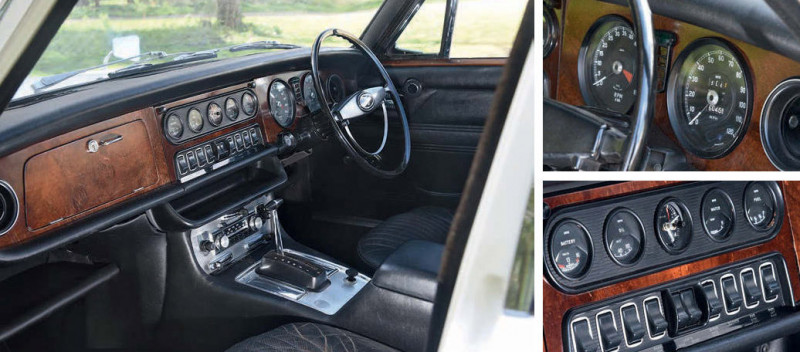
The same cannot be said of the rear quarters of the Rover, where passengers have to adopt a distinctly splay legged attitude in order to travel any distance in comfort. So let’s stick to the front, where instead of wood we find Formica trim, and instead of leather we find nylon. This really was the 1970s through and through – earlier P6s all had leather, though Formica was fitted to all but the earliest examples. The dash is somewhat more technical than the Jaguar’s, with one large plastic-fronted pod for the gauges and a wide shelf for oddments above two gloveboxes. Earlier models had a strip speedometer, but it was felt a little pedestrian for a sporting saloon of the 1970s. It’s also worth mentioning the door latches – so light and easy the doors can close and latch themselves, and with a muted, deep thunk noise that puts you in mind of a bank vault rather than a car.
This Rover is about quality – and this is one of the more obvious telltales. It boils down to a choice between tradition and modernity. If you like walnut and leather you’ll love the Jaguar. If you like the 1970s aesthetic the Rover will be the car for you. In neither case is comfort a problem, and we could understand why someone might advocate for either as the nicer solution.
So what are these two like to drive? We’re already in the Rover, so we’ll take that first. Turn the key and the traditional Rover V8 settles into a muted burble. We’re not sure about the small and convex interior mirror, but it’s something you get used to as you drive. What we do like is the short yet positive throw to the gear lever as you select first in this 3500S model – it’s direct, sporting, and feels distinctly upmarket when you consider the gearbox of alternatives like the Triumph 2500Pi. From rest, there’s lots of torque and while revving this car might sound fantastic, it’s riding the wave of torque that makes the most sense. And while it might lean hard in the corners, grip is commendable as is the steering feel – you know where the wheels are pointing, can push hard and can have al faith in the car to get you round. In 2023 this car is fun to drive – in 1968, when the V8 Rover came out, it must have been phenomenal.
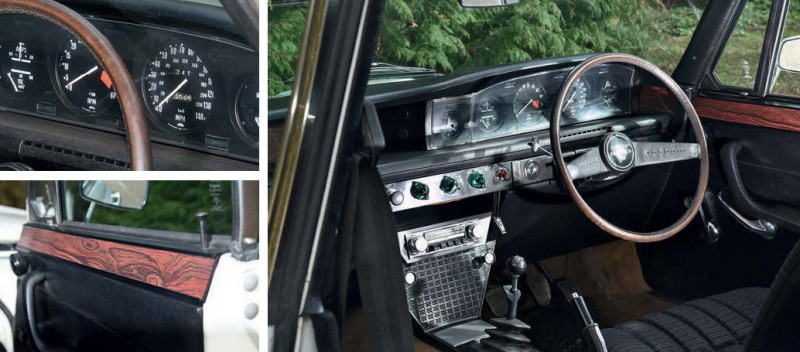
Which – and we apologise for this – the Jaguar is not. The steering is good – perhaps a little too light for modern tastes, but nicely geared – and there’s a lot of grip available to allow you to exploit a very composed chassis to the full. It doesn’t lean as much as the Rover which means you feel more confident in it, and it feels like a more stable car in general. The seats are also supportive, and there are few engines that sound like an XK on song. You can feel the sports car DNA despite the fact that this is a large saloon, and that’s something we love about each and every XJ we’ve driven. But the problem with this car lies under the bonnet. While the figures in our specification table look well matched, the Jaguar simply doesn’t feel as if it has the power or torque of the Rover, and it feels miles off in terms of the way it accelerates. While it will cruise at 60-70mph perfectly well, you’ll find yourself wishing you had waited for a 4.2 if you find a good B-road. When moving between locations on our photoshoot the difference in performance at junctions and as speed limits changed was noticeable, and we felt that a 4.2 would have rectified the imbalance. The problem there is the difference in price when these cars were new means that a 4.2 couldn’t really be considered a rival to the Rover. The Rover offers more power, then – but the Jaguar just about has the edge in the corners. So which one will come out on top?
CONCLUSION
In this, the first of a new series of twin test features for Classic Jaguar, unfortunately Coventry is on the back foot. Because the Rover 3500 is such a good car, the Jag has to be astounding to beat it. And while the 4.2 XJ6 is a marvellous machine and all its static qualities translate to the 2.8, the fact remains that this isn’t so much a leaping cat as a limping cat. The Rover feels far more effortless under acceleration than the Jaguar, and we can’t help but think that a P6 3500 owner would feel disappointed after a test drive in an XJ6 2.8.
The Jaguar certainly has more space – while an XJ Series I is no longer a large car, the P6 struggles to take six footers on the back seat and the boot of the Jag is a far more usable shape. It’s also the prettier of the two – with soft curves harking back almost to the E-type from some angles and gossamer-thin pillars making all round visibility a cinch. And while the Formica and nylon of the Rover would have been very up to date when these cars were new, the walnut and leather of the Jaguar has aged better with these elements still used in premium cars today.
The Rover feels like a better engineered product though, with what feels like more consideration in terms of quality, a drivetrain more befitting of a car at this price point with better power and torque characteristics making it a much more responsive vehicle, and with a saving of almost 25% even when we compare the pricier automatic against the Jaguar, it’s easy to see why the Rover owner might have wanted to save his money.
A Jaguar 4.2 would give us a very different result here – but remember that in period, that car was almost 50% more expensive than the Rover at over £3000 when specced with an automatic gearbox. And interestingly, if this test had been conducted using equivalent cars from just five years earlier – the Rover P6 Three Thousand Five and the Daimler V8-250 – it would be much harder to pick a winner. But in this company, to buy an XJ6 2.8 would be the mark of a dedicated Jaguar enthusiast.
THANKS TO: Kim Cairns Classic Cars, Snettisham, for supplying both cars.
“Because the Rover 3500 is such a good car, the Jag has to be astounding to beat it”
SPECIFICATION 1973 Rover P6 3500S
- ENGINE: 3528cc V8
- MAX POWER: 143bhp
- MAX TORQUE: 197lb ft
- ACCELERATION 0-60MPH: 9.0secs
- TOP SPEED: 122mph
- ECONOMY: 24mpg
- TRANSMISSION: 4-spd man
- PRICE NEW: £2208
- VALUE NOW: £5k-£15k
SPECIFICATION 1971 Jaguar XJ6 2.8 Automatic Series 1
- ENGINE: 2792cc I6
- MAX POWER: 147bhp
- MAX TORQUE: 182lb ft
- ACCELERATION 0-60MPH: 10.5secs
- TOP SPEED: 114mph
- ECONOMY: 22mpg
- TRANSMISSION: 3-spd auto
- PRICE NEW: £2617
- VALUE NOW: £2k-£9k
“The entry level XJ seemed to offer better value still by dint of its appearance; looking like a car from a class above.”


